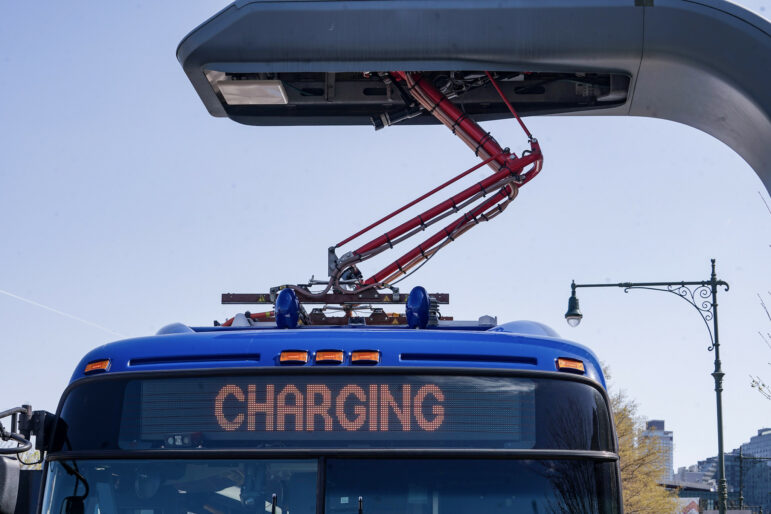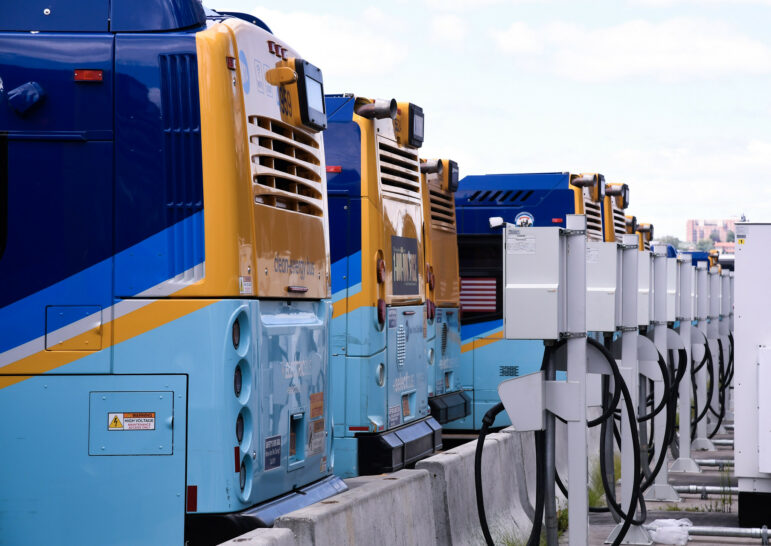This summer, utility companies must submit plans detailing how they’ll implement a series of solutions to make electricity rates more affordable for electric vehicles. But their plan has fallen short of giving the MTA the preferential rate it says it needs to able to foot the bill, as it seeks to transition to electric buses.

Marc A. Hermann / MTA
One of the MTA’s existing 15 electric buses being charged at a depot in Manhattan.The MTA, which runs the largest public bus system in the country, plans to transition its entire fleet of 5,800 buses to battery-powered electric vehicles by 2040. But it can’t afford to go through with the environmentally friendly move unless utility companies give the transit agency a hefty discount on its electricity bill.
Earlier this year, an order from the Public Service Commission (PSC) approved a series of solutions to make charging electric vehicles more affordable and gave utility companies until mid-July to submit plans for implementing them. But in a public response, the MTA described the changes as “wholly inadequate” in reducing the “cost barriers that constrain the MTA’s ability to convert its fleet.”
The plan gives the transit authority a discount for charging its fleet during off peak hours and overnight. MTA officials told City Limits, however, that it may not be enough—and that they were hoping for a preferential rate that would make it easier to foot the bill.
Electricity rates were designed to meet the demands of the city’s buildings and not its electric vehicles. The rates that apply to buildings where energy is constantly in use don’t match up to the needs of an electric bus that only charges a few hours a day when it runs out of juice.
Running the 15 battery-powered buses the cash-strapped MTA currently owns costs two to three times more than the price of traditional fuels like diesel or natural gas, according to the transit authority.
“[The MTA] is actually not [achieving] cost savings by going electric. In fact, there’s a cost premium,” said Alok Disa, senior researcher and policy analyst at the environmental non-profit EarthJustice. “In terms of public policy, we should be creating rules of the road, including utility rates, that incentivize electrification and don’t impede it.”
The MTA isn’t the only public entity trying to go electric: Mayor Eric Adams’ City of Yes plan, which strives to create a carbon neutral city, includes electrifying the city’s more than 24,000 vehicles as a cornerstone of its efforts. But without creating affordable charging rates and putting the infrastructure in place, these ambitious goals cannot be met, environmentalists say.
Mary Barber, state director for New York and New Jersey at the Environmental Defense Fund, said the MTA will most likely hit its 2040 electrification deadline, but it won’t be easy. “Lots of other pieces have to be in place for them to succeed.”

Marc A. Hermann / MTA
MTA electric buses charging at the Michael J. Quill Bus Depot on Manhattan’s west side.The utility rate problem
Utility bills are designed to meet the needs of commercial properties like an apartment or office space where electricity is constantly in use because the lights, air conditioning or heat are always running.
To account for that constant use, a “demand charge” or penalty is put in place to charge customers more for moments of peak energy consumption, when everyone is cranking up their AC or heater at the same time.
Electric vehicles, on the other hand, only need to be charged when their battery runs out. But they also require a lot more energy to charge that battery: the MTA estimates it would need between 230-250 megawatts to power its future all-electric bus fleet, which is enough electricity to run 12 small towns.
Transportation experts warn that if the MTA were subject to the same penalties consumers in commercial properties pay for peak demand hours, it would be paying astronomical fees.
“The older models for how we charge for electricity that uses demand charges are not really flexible,” said Alissa Burger, regional policy director at the nonprofit CALSTART. “We shouldn’t punish [electric vehicles] because they’re new, innovative technologies. Let’s change the system and the way we price electricity to be relevant and appropriate for current day technology.”
What transit companies like the MTA want, Burger explains, is to be offered a packaged deal that works “like a cellphone plan” where the consumer pays a preferential rate designed to meet their needs.
“They’re asking for plans that are more conducive to the operations of these electric buses,” she added.
Instead, utility companies joined forces and proposed what they call “a Commercial Managed Charging Program” that will begin in late 2023 and an “EV Phase-in Rate Design” that kicks in by 2025. Both solutions don’t include the preferential rate desired by the MTA, but rather, encourage transit authorities to reduce the burden of energy costs by having the companies avoid charging during peak hours—a practice known as “peak avoidance”—and to recharge at night instead.
But the MTA has publicly expressed that it would still be financially burdened if it were subjected to the demand charges currently in play.
Con Edison told City Limits in an email that demand charges won’t be waived. Instead, the energy company will “gradually phase in a demand charge as a customer’s load factor increases,” a move the utility company says “will reduce costs for the MTA and other customers.”
“Peak charging will be addressed through the commercial managed charging program and through the EV phase-in rate where the energy component of the rate will be assessed on a time of use basis to encourage off-peak charging,” Con Edison added.
But that solution “offers only a negligible adjustment to the demand charge schemes that are already in place,” the MTA said in its response to the plan.
The transit authority pointed out that states like California and Florida proposed better alternatives to traditional demand charges. California awarded commercial electric vehicles a 100 percent discount on demand charges for five years and Florida gave a progressive discount of 100 percent for the first three years, 90 percent for four and 80 percent by year five.
New York utility companies, by contrast, offered no discount and will require the MTA pay the demand charge for 88 percent of the charging time.
“The comparison is striking in that [the utility companies] proposed ‘solution’ for NY offers only a fraction of the cost relief provided in the other two states,” said the MTA.
Con Edison added in an email that the final program proposal “included an additional incentive for transit fleets” that “depends on a customer’s charging load and other factors.”

Marc A. Hermann / MTA
An MTA electric bus getting charged up at a charging station on the West Side Highway.Dodging financial roadblocks
Costly charging rates are among a long list of hurdles the MTA faces to make its all battery-powered fleet a reality.
So far, the MTA is in the first stage of its four part plan to electrify its fleet and owns just 15 electric buses. MTA told City Limits that 60 electric buses are slated to arrive next year and that 500 are expected to be deployed between 2025 and 2026.
The first phase alone will include building out two charging infrastructure projects, installing equipment at 10 of its 28 bus depots, and purchasing 15 test buses “to gain experience with new manufacturers and bus models.”
The MTA’s estimates it will need $1.1 billion for just phase one of its plan.
“This includes roughly $686 million for the purchase of battery-electric buses and $457 million for charging infrastructure, power supply, and supporting depot modifications and upgrades,” the plan says.
Funding for the next phases will be calculated “progressively, stage by stage” so the cost of the total package is still unknown, the MTA’s plan says.
“It’s going to be expensive,” said Jaqi Cohen, director of climate and equity policy at Tri-State Transportation Campaign. “We have more buses on the road in New York City than any other city in the country. And so that takes significant investment.”
The transit authority is confident, however, in the strides it has already made in securing federal funds. While it has not shared a total figure on how much has been raised so far, the MTA was awarded $116 million from the Federal Transit Administration in 2022 for electrification efforts.
On April 14th, over a dozen members of Congress signed a letter petitioning for the MTA to be given an additional $204 million in federal funding “to cover the differential in cost for the 255 battery electric buses included in Phase 3 of its transition plan.”
While the federal funding may only be a drop in the billions it potentially needs to transition its entire fleet, the state’s implementation of congestion pricing could funnel much needed money towards the MTA.
Earlier this month, the Biden administration gave New York the green light to proceed with the first-in-the-nation tolling system, which will charge drivers entering central Manhattan at peak times in an effort to curtail traffic and greenhouse gas emissions. The tolling infrastructure will be run by the public transit authority and has the potential to raise $1 billion annually for the MTA’s capital plan.
Advocates like Cohen support the move and say it will help electrification efforts, and set an example not just in New York but nationwide.
“The success of the MTA’s electric bus program will have ripple effects across the country because it is the largest bus network in the country. Other transit agencies will be looking at the MTA and taking lessons from them,” Cohen said.
“So we want them to be very successful.”









One thought on “Costly Utility Rates Could Jeopardize MTA’s Move to All-Electric Buses”
Demand charges make no sense if imposed for demand at off peak times. Demand charges are designed to provide an incentive for users to reduce peak power demand. Reducing peak demand saves every customer money because peak power is very expensive. If buses charge overnight, there’s no benefit to imposing a demand charge.